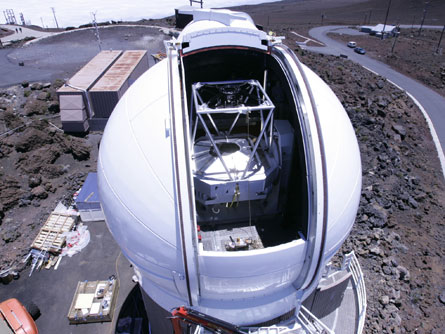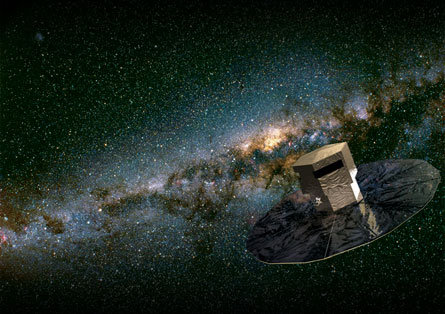New eyes to scan the skies
Two new telescopes will watch for asteroids, map the galaxy
Four hundred years ago, an Italian scientist named Galileo Galilei became the first person to see the craters on the moon. Galileo, who also observed four of Jupiter’s moons and the rings of Saturn, was one of the first people to use a telescope to study the sky. Since then, telescopes have become the most important tool used by astronomers.
All over the world — from the mountains of Hawaii to the icy plains of Antarctica — astronomers use telescopes to study the stars, galaxies and planets of outer space. Today, telescopes come in all shapes and sizes. Scientists are constantly finding new ways to make these instruments more powerful. In the next couple years, two new telescopes with different purposes are scheduled to see “first light.” (This is the phrase used by astronomers to talk about the first images produced by a telescope.)
 |
|
One of four planned Pan-STARRS telescopes has been built atop a Hawaiian mountain. Pan-STARRS will image the sky every night in search of large, near-Earth asteroids.
|
| Brett Simison |
One of the telescopes, called Pan-STARRS, could save humans from extinction. Nick Kaiser, a scientist who works on the project, says the Pan-STARRS telescope has been designed to find “90 percent of all killer asteroids, near-Earth asteroids bigger than 300 meters.” Smaller asteroids often crash into Earth, but if a giant “killer” asteroid were to strike our planet, it could mean the end of human civilization.
Pan-STARRS, like most telescopes, uses mirrors and lenses to provide pictures of outer space. Giant mirrors are used to “gather” light. They reflect the light onto the lens of a camera, which can then record the image.
When completed, Pan-STARRS will include four telescopes perched atop a mountain on the Hawaiian island of Maui. Only one telescope is in place and working now. Each telescope will take pictures of one patch of sky for about 30 seconds, and then move on to another patch. Every night, each telescope will take pictures of about 1,000 patches. Every week, each telescope will have photographed the whole sky.
Each of the four telescopes will take pictures of the same patches of sky. One telescope, working alone, may occasionally malfunction and incorrectly detect an asteroid. If there are three other telescopes working, astronomers can use them to see if there really is an asteroid coming our way. By using four telescopes instead of one, scientists hope to get a more accurate picture of space. If a giant asteroid were identified, astronomers would plot ways to deflect it or break it up long before it reached Earth.
 |
|
The European Space Agency’s Gaia craft, scheduled to launch in 2011 and illustrated here, will spin as its two optical telescopes map the Milky Way in 3-D.
|
| Medialab |
Another telescope, called Gaia, is being designed by astronomers in Europe — and it couldn’t be more different from Pan-STARRS. While Pan-STARRS will be looking for asteroids and comets headed for Earth, Gaia will be looking at our entire galaxy.
Gaia is designed to draw a map of the Milky Way, our home galaxy. Just as a map of your town gives you a picture of where things are located, Gaia’s map of the galaxy will tell astronomers where the stars reside. Over five years, Gaia will observe about a billion stars and other objects in our galaxy. Each object will be observed about 70 times.
Unlike Pan-STARRS, which will be constructed on firm Earth, Gaia will be launched into space strapped to a rocket. It consists of two telescopes, each focused at a different angle. These two telescopes act like Gaia’s “eyes.” The reason humans can see things in 3-D is that we have two eyes focused on the same object, at slightly different angles. (If you want to see a two-dimensional version of your world, try using just one eye.) By using two telescopes like eyes, Gaia can produce the first 3-D map of the positions of the stars it views.
Gaia, which is scheduled to blast off in 2011, will be a powerful telescope. If you were to use it on Earth, for example, you could stand 600 miles away from your best friends and still get a crisp and clear picture of their hair.
Gaia and Pan-STARRS are two of more than a dozen telescopes being designed by scientists right now. The next generation of telescopes will reveal new parts of our universe that will seem surprising, just as the moon’s craters must have seemed when observed 400 years ago. The universe, with all its planets, stars and other strange objects, is a complicated puzzle with pieces that we can see by using powerful telescopes. Astronomers of the future will gaze deep into space, gather more pieces, try to put them together and ask new questions. The big question, however, will always be the same: “What’s out there?”
Power words:
Telescope: An arrangement of lenses or mirrors, or both, that gathers visible light, permitting direct observation or photographic recording of distant objects.
Galaxy: A collection of stars, gas and dust that make up the universe. A galaxy contains an average of 100 billion solar masses (or 100 billion times the weight of the sun) and ranges in diameter from 1,500 to 300,000 light-years.
Going Deeper:







